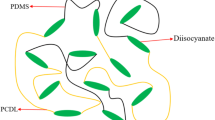Abstract
Intrinsic insulating and thermal conductive polymers were prepared by synthesizing liquid-crystalline polysiloxanes elastomer (LCPE) with chemical cross-linking (0.83 W/m K and 0.81 W/m K). The microscopic-ordered structures were found in LCPE and considered affording high thermal conductivity. Chemical structures were observed by hydrogen nuclear magnetic resonance spectroscopy (1H-NMR) and fourier transform infrared (FT-IR) spectroscopy. Microscopic-ordered structures were analyzed by polarizing optical microscopy, scanning electron microscope and X-ray diffraction. Thermal conductivities were calculated according to equation: λ = α·ρ·Cp. Thermal properties were researched by differential scanning calorimeter and thermal gravimetric analyzer. The results revealed that LCPE showed high thermal conductivity because of the microscopic-ordered structures existing. The phonon scattering was suppressed and the mean free path of phonon was extended maximally. In addition, phonon conduction path was more complete. Our study provided a useful method to enhance the thermal conductivities of intrinsic thermal conductivity polymer themselves.












Similar content being viewed by others
References
I. Seshadri, G.L. Esquenazi, T. Cardinal et al., Microwave synthesis of branched silver nanowires and their use as fillers for high thermal conductivity polymer composites. Nanotechnology 27(17), 175601 (2016)
W. Chen, Z.F. Wang, C.Y. Zhi et al., High thermal conductivity and temperature probing of copper nanowire/upconversion nanoparticles/epoxy composite. Compos. Sci. Technol. 130, 63–69 (2016)
Y. Li, L. Zhang, Z.Z. Hou, Preparation and properties of graphene oxide/glycidyl methacrylate grafted natural rubber nanocomposites. J. Polym. Environ. 25(2), 1–8 (2016)
L. Xu, W. Zhou, Y. Gong, et al., Comparative study on dynamic thermal-dielectric properties of epoxy composites with Al and Ni particles. J. Mater. Sci. Mater. Electron. 29(15), 13376–13388 (2018)
Q. Li, L. Chen, M.R. Gadinski et al., Flexible high-temperature dielectric materials from polymer nanocomposites. Nature 523(7562), 576–579 (2015)
H. Chena, V.V. Ginzburgb, J. Yangc et al., Thermal conductivity of polymer-based composites: fundamentals and applications. Prog. Polym. Sci. 59, 41–85 (2016)
H. Yeo, A.M. Islam, N.H. You et al., Characteristic correlation between liquid crystalline epoxy and alumina filler on thermal conducting properties. Compos. Sci. Technol. 141, 99–105 (2017)
K. Ahn, K. Kim, J. Kim, Thermal conductivity and electric properties of epoxy composites filled with TiO2-coated copper nanowire. Polymer 76, 313–320 (2015)
V. Singh, T.L. Bougher, A. Weathers et al., High thermal conductivity of chain-oriented amorphous polythiophene. Nature Nanotech 9, 384–390 (2014)
T. Giang, J. Kim, Effect of liquid-crystalline epoxy backbone structure on thermal conductivity of epoxy–alumina composites. J. Electron. Mater. 46(1), 1–10 (2017)
T. Zhang, T.F. Luo, Role of chain morphology and stiffness in thermal conductivity of amorphous polymers. J. Phys. Chem. B 120, 803–812 (2016)
H. Ma, Z.T. Tian, Effects of polymer chain confinement on thermal conductivity of ultrathin amorphous polystyrene films. Appl. Phys. Lett. 107, 073111 (2015)
X.Y. Hang, S. Wang, M. Zhang et al., Thermally conductive, electrically insulating and melt-processable polystyrene/boron nitride nanocomposites prepared by in situ reversible addition fragmentation chain transfer polymerization. Nanotechnology 26(1), 015705–015714 (2015)
Z.X. Zhong, M.C. Wingert, J. Strzalka et al., Structure-induced enhancement of thermal conductivities in electrospun polymer nanofibers. Nanoscale 6(14), 8283–8291 (2014)
L. Zhang, M. Ruesch, X.L. Zhang et al., Tuning thermal conductivity of crystalline polymer nanofibers by interchain hydrogen bonding. RSC Adv. 5(107), 87981–87986 (2015)
X. Xie, D.Y. Li, T.H. Tsai et al., Thermal conductivity, heat capacity, and elastic constants of water-soluble polymers and polymer blends. Macromolecules 49, 972–978 (2016)
V. Mathur, K. Sharma, Thermal response of polystyrene/poly methyl methacrylate (PS/PMMA) polymeric blends. Heat Mass Transfer, 52(12), 2901–2911 (2016)
S. Kawamoto, H. Fujiwara, S. Nishimura, Hydrogen characteristics and ordered structure of mono-mesogen type liquid-crystalline epoxy polymer. Int. J. Hydrog. Energy, 41(18), 7500–7510 (2016)
M. Akatsuka, Y. Takezawa, Ductive epoxy resins containing controlled high-order structures. J. Appl. Polym. Sci. 89(9), 2464–2467 (2003)
Y. Li, G.C. Zhang, Y. Jiang et al., Synthesis and liquid crystal properites of novel liquid crystal monomer: p-hydroxybenzoic acid p-cyano phenol ester. Chin. J. Synth. Chem. 19(6), 714–717 (2011)
S. Yu, C. Park, S.M. Hong, M.K. Chong, Thermal conduction behaviors of chemically cross-linked high-density polyethylenes. Thermochim. Acta 583(7), 67–71 (2014)
Acknowledgements
The authors would like to thank the Priority Research and Development Foundations of Shaanxi Provincial Government (Project No. 2018GY-174) and (Project No. 2018GY-115), the Science and Technology activity Foundation for overseas person of Shaanxi Provincial Government (Project No. 2017030) and National Natural Science Foundation of China (Project No. 51577154) for financial support of this work.
Author information
Authors and Affiliations
Corresponding authors
Additional information
Publisher’s Note
Springer Nature remains neutral with regard to jurisdictional claims in published maps and institutional affiliations.
Rights and permissions
About this article
Cite this article
Li, Y., Li, C., Zhang, L. et al. Effect of microscopic-ordered structures on intrinsic thermal conductivity of liquid-crystalline polysiloxane. J Mater Sci: Mater Electron 30, 8329–8338 (2019). https://doi.org/10.1007/s10854-019-01150-1
Received:
Accepted:
Published:
Issue Date:
DOI: https://doi.org/10.1007/s10854-019-01150-1




